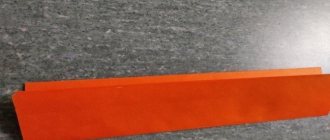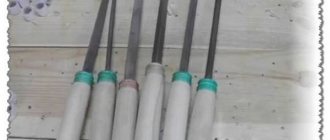A long wooden handle for a purchased garden hacksaw, which significantly expands the capabilities of such a hacksaw, and also allows you to attach it to homemade rods of different lengths.
Greetings to all do-it-yourselfers, as well as summer residents and gardeners!
Now the spring pruning of garden trees and shrubs is coming to an end. However, I want to share one homemade product that helped me a lot in pruning my garden this spring, and also greatly expanded the capabilities of my purchased garden hacksaw.
I must say that about three weeks ago, I bought this garden hacksaw.
It is not very expensive (about four hundred rubles), but at the same time it is quite convenient and cuts very well. In addition, this hacksaw is equipped with a sheath, which allows you to carry it on your belt (although I don’t really need it).
But, perhaps, the main advantage of this hacksaw is that it is collapsible, that is, its blade is attached to the handle with two bolts.
And thus, this blade can be quickly and easily detached from the handle using a screwdriver.
That is why I liked this hacksaw, because I decided that the removable blade could be attached to various homemade handles and long rods, which would significantly expand the capabilities of such a hacksaw in pruning the garden.
By the way, I must say that two years ago, I already made a homemade bar, onto which I adapted a hacksaw blade from an old collapsible saw (see my article “A simple homemade bar with a hacksaw for trimming branches”).
Canvas size
Depending on your task, you can choose different blade lengths. For simple boards and small bars, a length from twenty-eight to thirty centimeters is quite suitable. If construction work is underway, then it would be wiser to take a canvas from forty-five to fifty centimeters long.
The basic rule: the length of the product should be half the length of the hacksaw itself, otherwise you can forget about ease of use.
Wood saw: recommendations for choosing and storing a useful tool (115 photos)
Any good craftsman must have a hand saw for wood in his arsenal, since there is not always time to deploy and connect a circular saw, and a small amount of urgent work on wood still needs to be done. But how can you make the right choice when buying a hand saw for your home? After all, it needs to be easy to use and quite convenient.
Despite the fact that the design of any hacksaw is quite simple, when choosing it you still need to have some knowledge and be savvy. Otherwise, there is too high a chance that you will buy an inconvenient, low-quality tool.
It is also important to understand that there are different types of hacksaws and some of them are sold unsharpened. It turns out that you will not be able to use it immediately after purchasing it. Below we will look at which hacksaw is best suited for sawing various wood materials, and also describe all the details that are important to pay attention to when choosing this tool.
Choosing steel
In order to ensure that the service life of the tool is as long as possible, it is best to opt for high grades of steel used for the production of a particular blade. The ideal option if you are looking at photos of hacksaws for wood are those models that have stainless steel.
The tool can use hacksaw teeth depending on your preferences - simple ones, which you can easily sharpen yourself at home, or hardened teeth. The second type is disposable teeth, and once they are worn out, nothing can be done with them. They are darker in color.
What should the handle shape be?
This part of the saw is responsible for convenience when performing work. It is necessary that the chosen tool literally merges with the hand of the person performing construction work and is truly comfortable. A wide variety of plastics can be used to create handles.
An important point: you need to pay special attention to ensure that the material does not slip under any circumstances if it turns out that your hand becomes sweaty.
Usually, in high-quality hacksaws, for this purpose, grooves, special recesses and an additional rubberized lining are provided right in the body near the handle.
Types of hacksaws
By combining various factors, manufacturers developed and produced standard instruments that differed in handle shape and blade.
To understand for yourself how to choose a tool correctly and quickly, how to sharpen a hacksaw for wood in the future before performing work, it is important to carefully familiarize yourself with the types of saws that exist today.
Classic hacksaws
The main type of saw that can be found in almost any man, even if he is far from carpentry. Such a tool can have a blade of absolutely any length and with a different number of teeth. Very often, such a tool is additionally equipped by the manufacturer with special replacement blades.
Narrow instruments
Another name for such hacksaws is circular saws. They take their name from their main use - with their help you can cut out lines of any shape as clearly and accurately as possible. In addition, they can be used to cut holes in the shape of a square or circle.
Bow saw
This saw is an indispensable tool for most men. It is used for quickly cutting down the roughest parts of wood, as well as for cutting wood not only across, but also, most importantly, along the grain and much more.
Award
This type of saw will require effort to quickly master working with it, since it differs from other types in the presence of two handles. Mainly used for cutting various tenons.
Sharpening and tooth size
The size and sharpness of the teeth is one of the main criteria when choosing a hacksaw. The bottom line is that the small teeth on a hacksaw are for fine work and the long teeth are for rougher work, they are well suited for gardening where neatness is not an issue.
By looking at the photo of wood hacksaws with various teeth, you will see which hacksaw is right for you.
In the hacksaw market, there is a TPI unit, on which the cutting accuracy directly depends; it determines the number of teeth per 1 inch. For example, you need to cut a couple of chipboard boards, in this case it is recommended to use hacksaws with a TPI in the range of seven to nine, then the cut will be smooth and neat.
If you need to work in the garden, cutting down branches, for example, then accuracy is not so important; a hacksaw with a TPI of three to six will suffice. The tooth pitch can be from two and a half to six and a half millimeters and from one and a half to five millimeters.
The shape of the teeth of a classic saw is triangular and can be easily sharpened. However, in modern realities you can more often find hacksaws with trapezoidal teeth. It positions itself as a stronger and more durable saw.
But proper sharpening with such a tool will be impossible, because the steel from which the hacksaw is made does not lend itself to a simple file, and it will be almost impossible to repeat this shape. As soon as the saw becomes dull, we either change the blade or go and buy a new one.
Sharpening a hacksaw on wood with your own hands is not a difficult task, but it is not easy either. Before starting sharpening, it is necessary to carry out routing so that the blade does not jam during sharpening. To do this, we use a special tool called sharpening.
Sharpening itself requires completely different tools.
Hand saw for wood
In this article we will talk about what a hand saw for wood is and how to choose this tool.
How to make the right choice
Hand saws for wood have cutting teeth of different sizes. This characteristic determines the future cut, suitable types of timber and whether it will be comfortable to hold in your hands. However, there are a number of other indicators that are worth paying attention to when purchasing an instrument.
Main characteristics:
- blade width
- blade length
- tooth size
- handle shape
- blade steel grade.
The length of the file affects the width of the workpiece being processed, and also greatly simplifies the work. A long stroke allows you to spend less force, because during one movement the cut is carried out by a large number of teeth. However, a long canvas will have a noticeable spring. When working with hard types of wood, for example, ash, maple or oak, the hacksaw will not be convenient and will quickly become dull.
Most often, the blade has a width of 10 to 20 cm. Narrower files will break even with slight bending, and wider files are inconvenient for manual labor. Remember that when working with thin workpieces you need to use thin saws, and when working with thick ones, respectively, thick saws.
Many models have a plastic handle. Choose options with a rubberized backing, which protects against calluses and also allows for a tighter grip.
The saw tooth is the most important part of the tool. The teeth are:
- for universal cutting
- for cross cutting
- for longitudinal cutting.
Classification
Hand saws for wood come in a variety of configurations. Hence there are a large number of different models. The following types of hand saws are distinguished:
- classical. This type is the main one and almost every man has it. Such a saw can have a blade of different lengths with a different number of teeth. Most often, the tool has replaceable blades included in the kit upon purchase.
- narrow. This type of saw is also called a circular saw. It is named so because it helps to cut lines of various shapes, and very neat and clear ones. In addition, it is used to create through round and square holes. The file is quite narrow, has a large number of teeth, which can be located either on one working plane or on two. When working with such a saw you need to be careful. An uncertain movement can turn the blade in the other direction, for this reason, when choosing a hacksaw with a narrow blade, you need to choose high-quality hard steel that will not bend during operation
- with a butt. This hacksaw has a stiffening rib (shank), which does not allow the blade to bend during the cutting process. Consequently, the tool will not be able to make a cut below the width of the working part of the saw. This tool has a comfortable handle at an angle of 450 to the blade. This saw is easy to work with
- onion. In plumbing, a bow saw is an indispensable assistant. It is necessary in the process of cutting rough parts of the trunk, knots, as well as for cutting shapes from plywood and other wood materials. It can also be used to cut wood along and across the grain. The scope of use of a bow saw is so wide that it can become a substitute for a small woodworking machine. However, do not forget that the blade may fly off the mount or break during cutting.
- reward. A saw with an award will require a lot of effort from the master. This tool is similar to a plane. It has two handles. This saw is used for cutting grooves and tenons, and the depth of the holes and recesses can be made of different sizes. It can be used for rocks of any hardness
- folding. You can take this mechanical hacksaw with you on a hike or on vacation. Its main advantages: compactness, lightness, safety when folded. It has fine teeth and a short, pointed blade.
Types of teeth
The most common tooth shapes in hand saws are:
- dagger tooth It is used in classic wide and narrow hacksaws, as well as in bow saws. The tooth is made in the shape of an isosceles triangle, therefore, such hacksaws can work in both directions. The tooth spread is most often equal to 1/3 of the blade thickness per side. The teeth are set apart by the same amount in different directions. This type of setting is intended for cross-cutting, as it is aimed at breaking the wood fibers. A longitudinal cut is almost impossible, since the tooth does not destroy, but splits the fibers, which means it gets stuck between them
- chisel tooth. Made in the shape of an asymmetrical right triangle. Most often, such teeth have axle saws and hacksaws. A saw with such teeth only works in one direction. The top of the tooth is sharpened across the blade, for this reason it acts similarly to a chisel. Used exclusively for cross-cutting, because when cutting longitudinally it clings to the fibers
- oblique universal tooth. It is something in between the two types described above. The shape is an asymmetrical triangle, which is inclined in the direction of the cut, but at a smaller cutting angle. The leading edge is sharpened at 60° to the blade. This sharpening makes it possible to use the saw for both longitudinal and transverse sawing. Circular saws are equipped with these teeth.
- tooth with a sharpened top. It is obtained as a result of additional processing of a dagger or oblique universal tooth by partially grinding down the top of the triangle. As a result, three additional cutting edges are obtained, which make the saw more versatile for implementing different types of cuts.
- Japanese tooth Created in the form of a reverse wedge, that is, the thick part of the saw blade is closer to the workpiece, which means these saws do not need setting. The tooth has a sharp sharpening angle and a sufficiently high height to ensure maximum sawing efficiency
- Jet-cut. Dagger saw teeth are combined into groups of eight, with six of them set apart and the last two not
- wolf tooth A very interesting form, which is used for working with raw wood, the fibers of which are difficult to break.
Instructions for properly sharpening a hacksaw
Before starting work, you need to firmly clamp your blade in a vice so that it does not wobble. Having secured the blade, take a file and begin sharpening the left edge on the first tooth. When doing this, you need to hold the file at a sixty-degree angle.
Read also: Unit of measurement of electrolyte density
Use a file using even and smooth movements. In exactly the same way, you should sharpen all the left parts of the odd teeth, and then the right ones. Then we turn the blade over, fasten and sharpen the teeth of the even row.
Having finished the work, be sure to clean the blade from burrs with a specialized velvet file.
The right approach to choosing a hacksaw
Works in which hacksaws are used are divided into carpentry and joinery. In carpentry, accuracy is more important, while in carpentry, speed is more important.
First of all, you should pay attention to the quality of the metal of the blade; to do this, we take the hacksaw in our hands and bend it 30-45 degrees. This must be done as carefully as possible, since low-quality metal is very easy to break.
After carrying out this operation, let's look at the bend; if a slight deviation appears there, then the metal of this product is of very low quality.
The most important criterion when choosing your hacksaw is the price. Naturally, the choice before you is a cheap Chinese hacksaw of poor quality or an expensive saw from a well-known brand. However, having overpaid once, you will no longer have to constantly change the blade or buy a new tool. Major brands pay close attention to the quality of steel and hardening used in their blades.
The main tasks of the teeth are to remove sawdust and, directly, to cut the wood itself.
Teeth with a TPI setting of up to seven are fast and easy to use. Therefore, the choice of a hacksaw should depend entirely on your own needs.
Wood saw - how to choose the best tool. 70 photos of the best paintings and basic characteristics
Suppose you have a need to process wood or some kind of wooden product using a hacksaw. There seems to be no difficulty in picking up a hacksaw and starting to work, but you need to clarify which type of tool is suitable for a particular job. There are dozens of models, and their difference is not only in price and manufacturers.
The tool is not complicated to use, but has several nuances that are worth considering. In this article we will try to analyze the main details that you need to pay attention to.
Characteristics
The hacksaw itself consists of a blade and a handle. It is worth paying attention to the grade of steel for the blade; the quality and ease of operation will depend on this. Nuances such as blade length, tooth size, steel type and handle type are the main ones when choosing a hacksaw.
Narrow hacksaw
A small narrow hand saw, consisting of a straight thin blade and a handle. It mainly serves for various thin. Most often, it has a blade with triangular double-sided teeth.
One of the main disadvantages of this type of hacksaw is the possibility of deflection during your work with a wooden product.
Materials and tools
To make such a handle, I needed the following accessories:
Materials and fasteners:
- Wooden plank 1.2 cm thick, 3.5 cm wide, and 1 m long;
- The hacksaw blade itself;
- Two M6 furniture bolts, 3.5 cm long, with washers and wing nuts.
Tools:
- A jigsaw with a file for shaped cutting;
- Electric drill;
- Hand plane;
- Metal drill with a diameter of 6 mm;
- Sandpaper.
Classic saw
A simple hacksaw is, of course, equipped with a completely different types of teeth, as well as different blades that can be changed.
Bow saws
This is a heavy-duty hacksaw. The main advantage of working with this type is the ability to work with the product you need from absolutely any angle. Using a bow saw, you can process the material from any side, lengthwise and crosswise, and make complex workpieces alone.
A small hacksaw is perfect for small jobs in the garden; it is not recommended to use it when sawing large materials.











